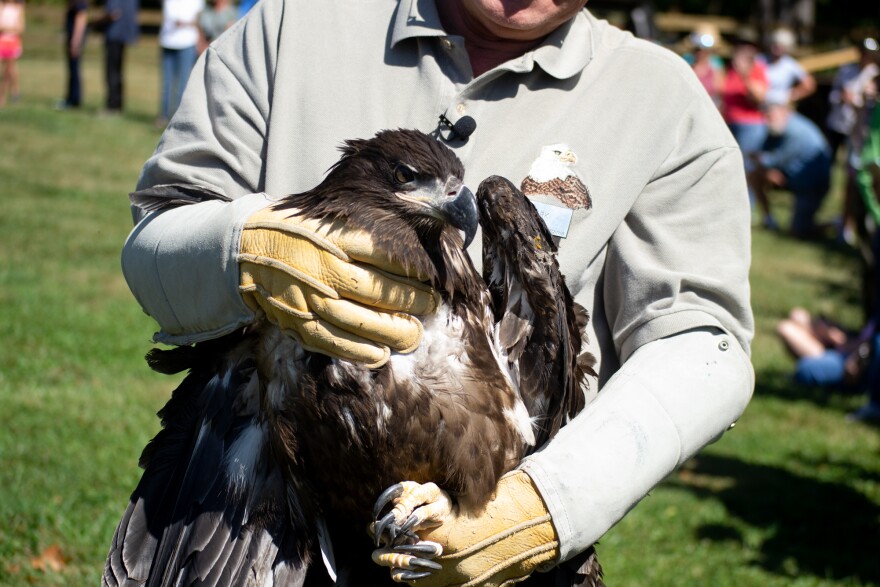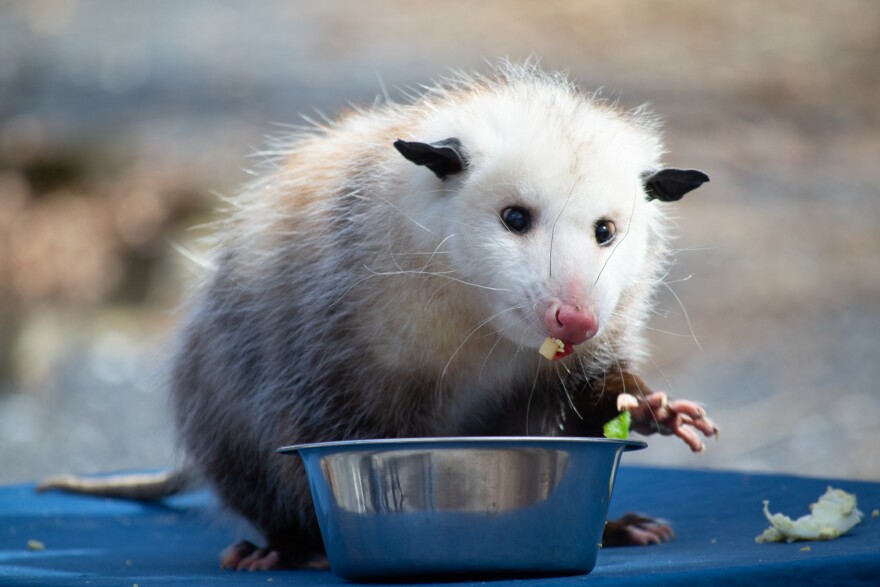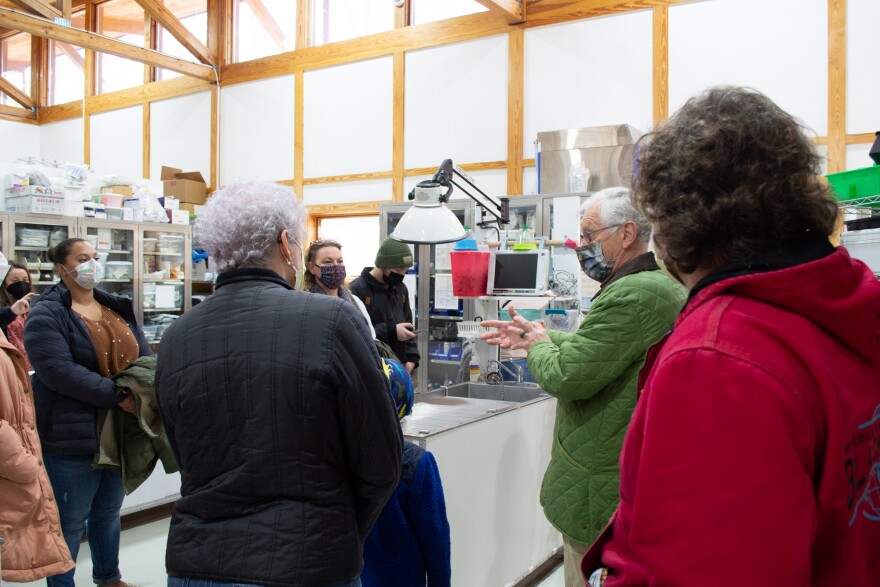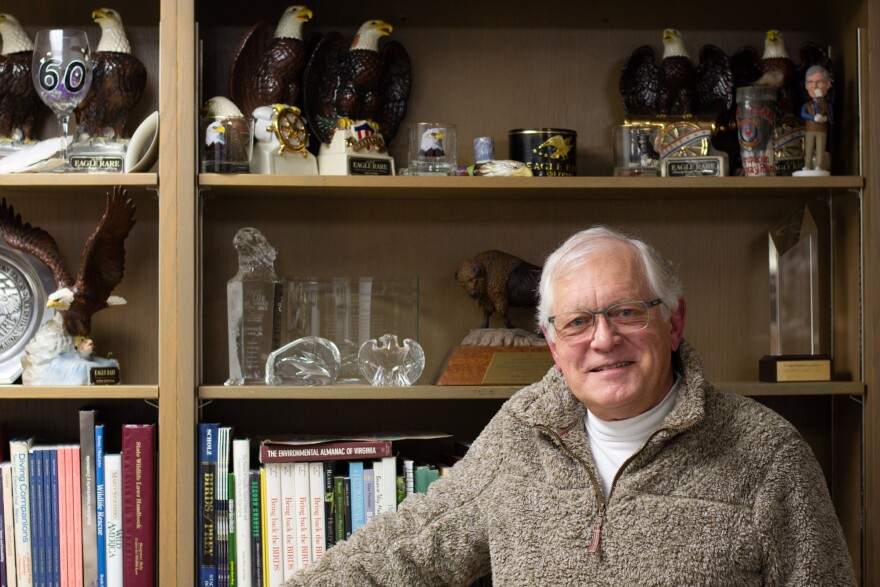Ed Clark, the co-founder and president of the Wildlife Center of Virginia in Waynesboro, has announced his retirement after more than four decades at the organization's helm. WMRA's Randi B. Hagi sat down with him to talk about the center's origins and impact, and filed this story.
Ed Clark has long been a force of, and for, nature – steering the Wildlife Center from its infancy through four decades of meteoric growth. His enthusiasm draws people in, whether he's releasing an eagle in Shenandoah County —
ED CLARK: On the count of three. One, two, three! [sound of wings flapping, camera shutters] Go, bird!

– or hosting television shows – such as VPM's Untamed.
CLARK: [water dripping in Grand Caverns] … Now we understand that the cave is far more important, not just as a tourist attraction, but as a major component of the ecosystem, and of the life cycle of the bat.
RYAN BROWN: Ed is absolutely a conservation giant.
Ryan Brown, the executive director of the Virginia Department of Wildlife Resources, has worked with Clark for more than 15 years.
BROWN: He's a name that everyone across this state knows and respects for the work that he does, for the wonderful person that he is, and most of all, for his passion.
Earlier this month, 72-year-old Clark announced his retirement after leading the teaching hospital and public outreach organization for 41 years.
CLARK: Now, I'll still be involved! I'm not retiring from conservation. I'm not retiring from a passion for wildlife.

We sat down for an interview in his office, under bookshelves lined with awards, photography books, congressional commendations, and eagle-shaped bourbon decanters. Clark said his love of nature was cultivated early on by his Uncle Barney, on 52 forested acres in Pennsylvania.
CLARK: We would literally just roam the woods and play and build forts and catch crayfish in the creek, and do that sort of thing, and so I was just steeped in an outdoor tradition.
He grew up in Rappahannock County, and after graduating from Bridgewater College, taught at the Virginia School for the Deaf and the Blind for five years. Then, in 1979, he became the first executive director of what is now the Virginia Conservation Network.
CLARK: Once I got my taste of professional conservation advocacy, the hook was set and the die was cast.
In 1982, he sat down for lunch with his first wife, Nancy Sheffield, and others to discuss how Virginia needed a facility to provide long-term care for injured wildlife. Clark took that as a challenge, and in November of that year, the Wildlife Center of Virginia was officially incorporated.
Sheffield, now a retired veterinary technician and professor, co-founded the center and served on its board of directors for 16 years.
NANCY SHEFFIELD: At the time, we were living on some property that my parents owned that was originally a horse facility, and so we had a big barn that just had some hay in it, and nothing else was going on, and stalls downstairs, and so we were able to convert them into something that was somewhat [chuckles] appropriate for housing wildlife!
After three years, and with a $25,000 donation from the Mars family (of the Mars, Inc. candy empire), they expanded to a double-wide trailer in Weyers Cave.
CLARK: So we started our post-doctoral training program in that double-wide. We started our research program in that double-wide. We mounted a campaign that resulted in one of the most dangerous agricultural chemicals ever brought on the market to be banned.
Long and fascinating story short, the Wildlife Center and the Department of Game and Inland Fisheries determined that an eagle that was admitted in 1985 had been poisoned by Furadan, a common grain pesticide. As Clark and his team tried to report the chemical's effects to the Reagan-era Environmental Protection Agency, they found the manufacturer had falsified tests about its safety. A concerned EPA biologist smuggled documents to Clark – Pentagon Papers style – that showed agency administrators were involved in a coverup.
CLARK: There were a lot of heroics back then!

The center moved to its current location, a spacious hospital tucked into the woods just south of Waynesboro, in 1995. Among its many distinctions, it's the only facility in the state authorized to rehabilitate black bears. Each year, they take in orphaned cubs that must be raised properly so that they don't habituate to human contact.
CLARK: Probably four or five years ago, we had 21 cubs we were over-wintering, and it was a mild winter, so none of them would go to sleep. … We were preparing something in the neighborhood of 200 pounds of bear food per day! And let me just tell you, it put a dent in the grocery budget! [laughs]
Over four decades, the center has grown from a four-volunteer affair to a 36-employee organization that trains wildlife veterinarians from all over the world. Sheffield herself went on to teach students in Colorado who interned there. Clark explained that the center's mission is not fixing broken animals, but teaching the world to care about and for wildlife.
CLARK: The thing that I find most gratifying about my career here has been the stories I hear from people who say, "I never knew," "you taught me," whatever it was. You taught me not to be afraid of snakes. … You taught me not to throw litter on the side of the road because it just attracts wildlife to harm's way.
The board of directors has retained a consultant to find Clark's successor. When it's time for him to migrate – tentatively, at the end of March – he'll take on the role of president emeritus. He hopes to have more time for nature photography, fishing, and horseback riding.
[kestrel calls]





